Etruscans return to Modena, in an exhibition at the Estense Galleries featuring artifacts never before displayed
From May 25 to October 1, 2019, the Galleria Estense in Modena is hosting the exhibition Lo specchio di Celestino. Etruscan Archaeology in Modena in the First Half of the Nineteenth Century, which presents the most important finds from the necropolis of Galassina di Castelvetro, as well as archaeological works found in the same burial context and never exhibited until now. The exhibition thus focuses on the small Etruscan burial ground found in 1841 in the fields of Galassina di Castelvetro, datable, based on the materials known so far, between the late sixth and fifth centuries B.C. Here, the owners of a property, during agricultural work, found the remains of four Etruscan incineration tombs, whose rich grave goods, among the most valuable from the Etruscan period in the Modena area, were purchased by Francis IV Habsburg-Este, duke of Modena, to enrich his collection of antiquities and the Museo Estense. The exhibition takes its title from Celestino Cavedoni (Levizzano Rangone, 1795 - Modena, 1865), an archaeologist from Modena, a great expert on Etruscan art and discoverer of the tombs of Castelvetro.
The exhibition itinerary proposed by the show presents the most important pieces of the grave goods, referable to a deceased woman, from Tomb I of Galassina, that is, the richest, and also the best-known burial, exhibited at the Civic Archaeological Museum of Modena until the end of May 2018, and now returned to the Estense collection, together with archaeological works from the same burial context, hitherto unpublished. Of the entire Tomb I trove, the best known and most studied objects are the mirror and the corded cista (cylindrical-shaped vessel), as well as the basin.
The rest of the objects were commonly thought to have been dispersed, until careful inventory matching and an examination of the deposits of the Galleria Estense in Modena made it possible to recognize with good certainty other finds from Tomb I, such as the strigil handle (an instrument for cleansing the body after bathing), one of the three necklace vagos (an element, hollow inside, formed by two soldered hemispheres) in the shape of a glass paste head and two fragments pertaining to the glass paste balsam bowl. These findings made it possible to reconstruct the unity of the trousseau acquired by Francis IV, and provided the possibility of its finally complete study.
A series of didactic panels will allow the visitor to delve into the context of the discovery of the Galassina mirror, in the different cultural, artistic and collecting aspects related to it. Finally, a catalog published by SAGEP accompanies the exhibition. The exhibition can be visited during the opening hours of the Galleria Estense: Tuesday to Saturday from 8:30 a.m. to 7:30 p.m., Sundays and holidays from 10 a.m. to 6 p.m. Tickets: full price 6 euros, reduced price 2 euros (for 18 to 25 year olds), free for under 18. For info visit the Este Galleries website.
Pictured: glass paste necklace pendant depicting a male head, produced by workshops in the Phoenician-Cypriot area
Source: press release
 |
| Etruscans return to Modena, in an exhibition at the Estense Galleries featuring artifacts never before displayed |
Warning: the translation into English of the original Italian article was created using automatic tools. We undertake to review all articles, but we do not guarantee the total absence of inaccuracies in the translation due to the program. You can find the original by clicking on the ITA button. If you find any mistake,please contact us.





























